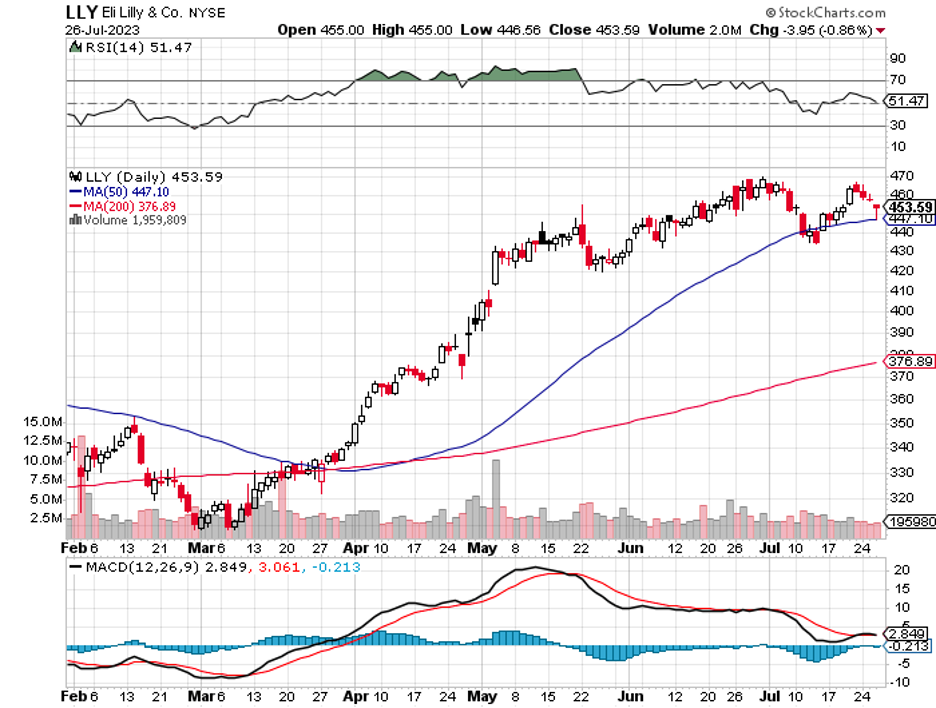Mark my words. The healthcare sector is on the cusp of a seismic shift. By 2033, I expect to see the dawn of a trillion-dollar enterprise. Now, you might think I've lost my marbles, but hear me out.
The prime contender for this prestigious title? Eli Lilly (LLY).
Now, Lilly is comfortably lounging at a market cap of $425 billion, a massive figure, yes, but still less than half of our $1 trillion target. Lilly's stock would need to scale up by a staggering 135% to breach the trillion-dollar threshold.
Daunting, right?
But if you break it down to an annual growth rate over a 10-year span, we're looking at a relatively modest compound rate of around 8.9%. With Lilly's recent track record and brimming product pipeline, this growth trajectory doesn't seem so far-fetched.
A closer look at Lilly's pharmaceutical lineup reveals a host of innovative treatments. Lilly's recent contributions to diabetes care - Mounjaro, Jardiance, and Trulicity - represent significant strides.
Adding to the fray are Taltz, a cutting-edge psoriasis solution, and Verzenio, a life-saving breast cancer drug. A peek into Lilly's late-stage pipeline reveals potential blockbusters in the making, like lebrikizumab for atopic dermatitis, mirikizumab for immunology, and donanemab for the relentless battle against Alzheimer's.
Then, there's the $1.9 billion acquisition of Versanis Bio, positioning Lilly at the precipice of the weight-loss market.
Lilly stands out with its robust line-up in the race for weight loss solutions. Mounjaro, initially a diabetes drug, has demonstrated potential as a weight-loss aid in clinical trials, with participants on the highest dosage shedding up to 22.5% of their body weight over 72 weeks.
Yet, the sector is intensely competitive, with giants such as Novo Nordisk (NVO), Amgen (AMGN), and Pfizer (PFE) on the battlefield. While Lilly's recent acquisitions present strong prospects, forecasting revenue growth over the next decade remains an intricate puzzle.
Notably, weight-loss solutions form a crucial part of Lilly's growth plan and could contribute more than 60% of the company's annual revenue by the mid-2030s.
Meanwhile, Lilly is developing potential breakthroughs in Alzheimer's treatment, with donanemab showing promise in clinical trials. This treatment has a mechanism that targets amyloid plaque, often found in the brains of Alzheimer's patients.
If approved, sales could reach a projected $3.9 billion by 2027.
Despite these promising avenues, caution is warranted. Lilly's stock is trading at 51.75 times its forward-looking earnings estimates. While the prospects for Alzheimer's and weight management treatments show promise, their success is far from guaranteed.
Historically successful drugs like Humalog and Alimta have seen their sales decline by 25% and 83%, respectively, as they lose exclusivity and face competition from lower-cost alternatives.
A company's value is often tied to its latest blockbuster in the pharmaceutical sector. Patent protection typically lasts 25 years from the date of discovery, with about half this time spent on testing. This leaves a limited window for profitability.
Investing in Lilly or any other pharma stock based on earnings expectations over 50 times isn’t always a guaranteed win. The firm’s upcoming offerings could indeed be significant earners, but they must offset foreseeable losses from other areas.
For instance, Trulicity, Lilly's top-selling treatment, generated nearly $2 billion in sales during the first quarter of 2023. However, Trulicity's revenue may be cannibalized by Lilly's own Mounjaro, with looming patent expirations set to intensify the pressure from 2027.
With robust profit margins exceeding 20%, the ascent of Eli Lilly to a trillion-dollar valuation is not only a bold prediction but also a captivating journey to monitor.
While this forecast appears to be grounded in solid reasoning and well-articulated facts, the reality of this industry is inherently marked by uncertainty and continuous change. Without the caveat of patent expiration, Lilly would be an unequivocal strong buy.
But given this reality, investors might be wiser to monitor Lilly first, rather than rush into a commitment. I suggest patiently waiting and buying the dip.

